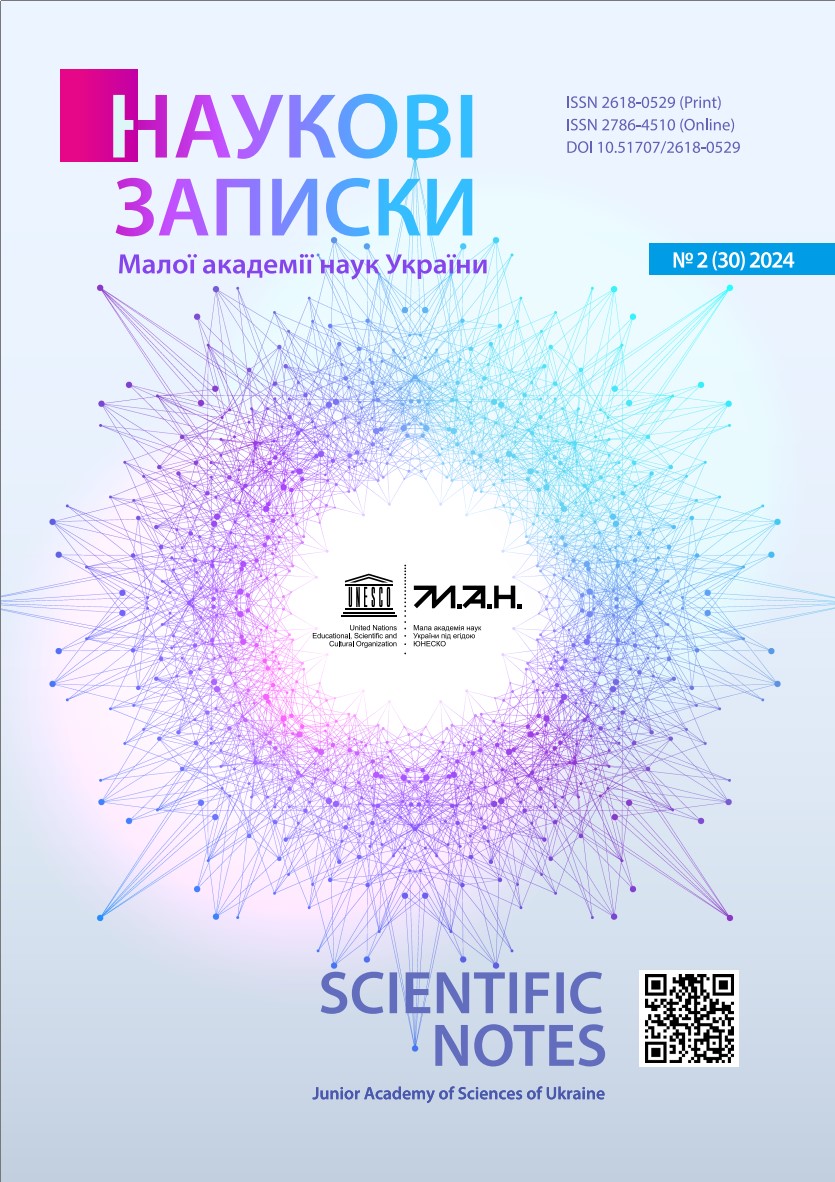Creative environment as a factor of performance of the STEAM approach to the project activity of education acquisitions
DOI:
https://doi.org/10.51707/2618-0529-2024-30-11Keywords:
STEAMeducation, STEAMproject, creative environment, creative contests for education seekers, subjects of the creative environment.Abstract
One of the primary technological tasks in the 21st century is the transition to alternative energy sources. In Ukraine, this task has gained new relevance due to military actions and significant destruction of the country’s energy system. A necessary condition for the implementation of this task is the availability of scientific, technical and engineering specialists. However, worldwide, there is a trend of decreasing interest among education seekers in studying subjects of natural, technological, mathematical educational fields, which resulted in a low number of those wishing to acquire a profession in the natural and mathematical direction and, accordingly, in the future, specialists who can increase the country’s competitiveness on the world market. Creative contests popular among young people are held in Ukraine every year, at which students of education from all over the country present their STEMprojects — the AllUkrainian competition for the defense of scientific and research works of students who are members of the National Academy of Sciences, the AllUkrainian competition for inventive and rationalizing projects in the ecological and naturalistic direction, the AllUkrainian competition for youth scientific and technical projects “InventorUA”, AllUkrainian scientific and technical competition “EcoTechno Ukraine”, AllUkrainian competition of youth projects on energy saving “Energy and environment”, AllUkrainian competition “Energy efficiency and ecology for schoolchildren”, etc. There is a widespread misconception that student creative projects are the result of the work of only the schoolchildren themselves. This approach is mainly aimed at external motivation and negatively affects the selfesteem of students. From the experience of the authors, a great role in the creation of these projects belongs to the creative environment organized by STEMteachers in the educational space. The article based on the example of the implementation of the innovative team STEAMproject “Portable solar installation “Sun Flower” as a source of thermal energy in the field” substantiates the effective influence of the creative environment on the effectiveness of the productive activities of students.
References
The New Ukrainian School: Conceptual Principles of Secondry School Reform. (2016). Retrieved from https://mon.gov.ua/storage/app/media/zagalna%20serednya/Book-ENG.pdf.
STEM 2026: a Vision for Innovation in STEM Education. (2016). Washington, District of Columbia : Office of Innovation and Improvement, US Department of Education. Retrieved from https://innovation.ed.gov/files/2016/09/AIR-STEM2026_Report_2016.pdf.
Mekhed, O. B., & Mekhed, D. B. (2022). Vykorystannia tekhnolohii STEM/STEAM z metoiu populiaryzatsii naukovoi diialnosti sered zdobuvachiv osvity [Use of STEM/STEAM technologies to popularize scientific activities among students]. Proceedings of II Vseukrainska naukovopraktychna konferentsiia “Innovatsiini praktyky naukovoi osvity” — The 2nd AllUkrainian Scientific and Practical Conference “Innovative practices of scientific education” (pp. 658– 663). Kyiv : Instytut obdarovanoi dytyny NAPN Ukrainy [in Ukrainian].
Stryzhak, O. Ye., & Zavalevskyi, Yu. I. (Eds.). (2023). Svit innovatsiinykh mozhlyvostei: aktualni pytannia rozvytku STEM [The world of innovative opportunities: current issues of the development of STEM education]. Kyiv [in Ukrainian].
Bykov, V. Yu. (2009). Modeli orhanizatsiinykh system vidkrytoi osvity [Models of organizational systems of open education]. Kyiv : Atika [in Ukrainian].
Shvai, R. I. (2013). Tvorche navchalne seredovyshche dlia formuvannia kreatyvnoi osobystosti [A creative learning environment for the formation of a creative personality]. Osvita ta rozvytok obdarovanoi osobystosti — Education and development of a gifted personality, 11, 14–18 [in Ukrainian].
Polikhun, N. I., Postova, K. H., Slipukhina, I. A., Onopchenko, H. V., & Onopchenko, O. V. (2019). Uprovadzhennia STEM osvity v umovakh intehratsii formalnoi i neformalnoi osvity obdarovanykh uchniv [Implementation of STEM education in the conditions of integration of formal and informal education of gifted students]. Kyiv : Instytut obdarovanoi dytyny NAPN Ukrainy [in Ukrainian].
Helioustanovka [Portable helio installation]: pat. 155918 Ukrainа: MPK F24J2/02 24S20/20 (2018.01), F24S23/00. № u 2023 04725 Ukrainа: statement 06.10.2023. (2024). Bul. № 16 (1) [in Ukrainian].
Andreev, A. M., Andreyeva, O. A., Zaiets, H. D., & Krotova, O. M. (2023). Portatyvna helioustanovka “Kvitka Sontsia”: analiz konstruktsii ta pryntsyp dii. [Portable helio installation “Flower of the Sun”: analysis of the design and principle of action]. Molodyi Vchenyi — Young Scientist, 11 (123), 1–7. DOI: https://doi.org/10.32839/2304-5809/2023-11-123-22 [in Ukrainian].
Zakon Ukrainy Pro okhoronu prav na vynakhody i korysni modeli pryiniatyi 31 hrud. 1993 roku № 3687-ХІІ [The Law of Ukraine On Protection of Rights to Inventions and Utility Models from December 31 1993, № 3687-ХІІ]. Retrieved from https://zakon.rada.gov.ua/laws/show/3687-12#Text [in Ukrainian].
Downloads
Published
How to Cite
Issue
Section
License
Copyright (c) 2024 Scientific notes of Junior Academy of Sciences of Ukraine

This work is licensed under a Creative Commons Attribution 4.0 International License.













